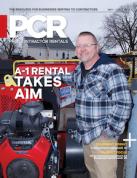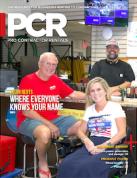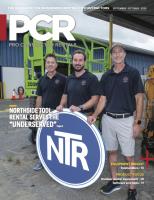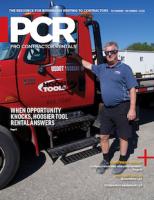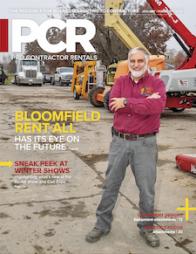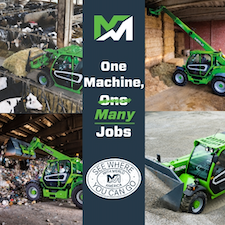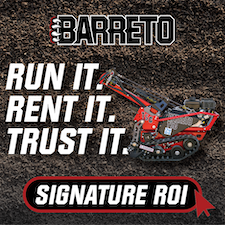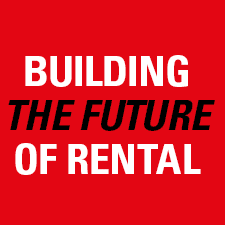Equipment insight: Remote-controlled equipment
Industry experts from Bobcat Company, Brokk Inc., Volvo CE, JLG, Volteq Equipment, Magni Americas, Manitou and Teleo share how remote-controlled equipment can make safer, more productive job sites.
 |
|
Sawyer Hanson |
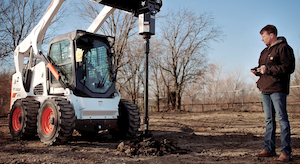 |
|
Doosan Bobcat offers two options for controlling compact loaders remotely: Bobcat MaxControl Remote Operation and Bobcat radio remote control system. For either system, a base requirement is the loader must be equipped with Bobcat’s Selectable Joystick Control (SJC) system and both require a hardware kit to be installed on the loader. |
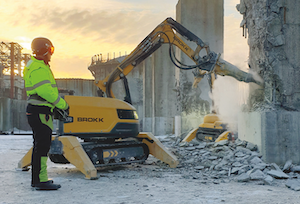 |
| With remote operation, the user can position him or herself in a safe location where there is no risk of falling and no risk of material striking or burying them. |
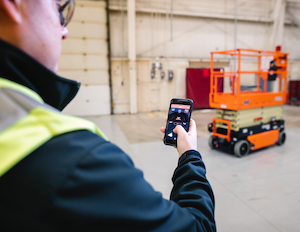 |
|
JLG also offers a Mobile Control option for scissor lifts that allows machine operators to drive, steer and load a stowed scissor lift from a mobile device. |
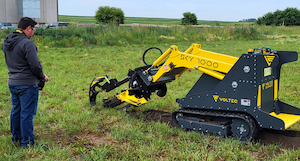 |
| First shipments of Volteq’s new SKY 1000 battery powered mini track loader will begin in Q4 of 2023 and include radio remote control as standard. |
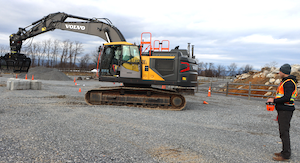 |
| Two-way communication via a radio transmitter and receiver allows the operator to communicate electronically with the machine. The Volvo system can be easily turned on and off by a switch inside the cab, and a light beacon on the outside of the machine alerts those on site when the remote operation mode is in use. |
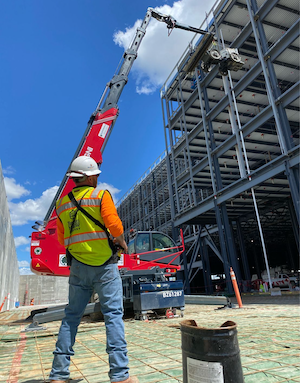 |
| All Magni machines including rotating, fixed boom and heavy lift models can be operated using a radio remote control. |
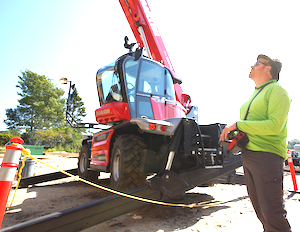 |
| Manitou’s MRT Vision+ lineup of rotating telehandlers feature two remote control options: one to provide remote control of the boom when the unit is on stabilizers and the second to provide remote control of the drive and boom operation while on tires. |
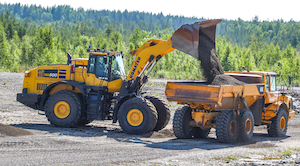 |
| Teleo retrofits existing heavy equipment and turns them into supervised autonomous and remote-operated machines. |
Economical iOS solution
Currently, Doosan Bobcat offers two options for controlling compact loaders remotely: Bobcat MaxControl Remote Operation and Bobcat radio remote control system. For either system, a base requirement is the loader must be equipped with Bobcat’s Selectable Joystick Control (SJC) system and both require a hardware kit to be installed on the loader.
Bobcat MaxControl is a technology paired with an iOS app that allows operators to remotely operate compatible Bobcat compact loaders. Bobcat MaxControl is considered a more economical solution as the technology is at operators’ fingertips through his or her iPhone or many other iOS devices. This allows them to choose the screen size that best fits their application need. Because it’s app-based, operators have access to the newest enhancements by simply updating the app.
The Bobcat radio remote control system includes a belly box for controls. Advantages of the radio remote control kit are physical joysticks and a longer operating range.
Bobcat MaxControl offers a lower cost of entry and ease of use, but each system allows operators to control their Bobcat loaders and attachments from outside the cab or from the cab of another machine. These technologies act like an extra set of hands when help is limited. Two-person jobs can now be handled by one worker, and trips in and out of the cab are minimized.
Bobcat MaxControl provides a remote-control solution for applications in many markets including construction, demolition, agriculture, landscaping and recycling.
Some of the many practical benefits of Bobcat MaxControl remote operations include reducing operators’ trips in and out of the cab to pass through gated entrances; to gain a better operational view while loading and unloading Bobcat MaxControl-equipped loaders from trailers; and to load trucks or backfill from the cab of another machine, turning two-person jobs into tasks easily managed by one operator.
Rental centers contemplating on bring remote-controlled equipment into their fleets need to think about two things: education and application.
Education: Rental companies must first understand how remote operations work and the job site advantages these systems can provide. Rental company staff needs to familiarize themselves with all the training materials and take the time to understand the system before they begin to rent units equipped with this technology. When rental companies first demonstrate the capabilities of Bobcat MaxControl to potential renters, they can see real-world applications of the technology and its tremendous benefits.
Application: The Bobcat MaxControl system provides the operator with another option for machine control on the job site. The technology reduces trips in and out of cabs and it can provide the operator a different view of the job site and make it possible for one person to accomplish jobs that otherwise require help.
Remote operation is not as complicated as some first-time users may think. The more familiar rental center staff becomes with the technology and its functionality, the easier it will be to show real-world benefits and applications to potential customers. Emphasizing the technology’s ease of use, efficiency and streamlined approach to completing tasks can easily demonstrate its benefits to an operator.
Rental companies can promote the many benefits of Bobcat MaxControl including cost savings, time savings and increased productivity. If demand indicates, they always have the option of adding the Bobcat radio remote control kit to their fleet as well.
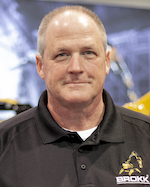 |
|
Jeff Keeling |
Remote control improves safety, productivity
All Brokk demolition machine models — from the Brokk 70 to the Brokk 900 — are remote-controlled. In fact, the Holmgren brothers’ first Brokk prototype, developed in the 1970s, was remote-controlled because they wanted to offer a safer, more efficient way to clean furnaces in metal processing plants. Until that time, workers were entering hot furnaces with blocks of wood under their feet and masks on their faces while they chipped slag and brick with hand tools. You can imagine what a miserable, dangerous, time-intensive task that was. Introducing a remote-controlled machine that could do that work drastically improved safety and productivity.
Today, Brokk’s remote-control capabilities are relevant for the very same reasons in many industries, including demolition, metal processing, cement production, tunneling, mining, nuclear, and search and rescue.
Brokk customers continue to find the safety benefits very compelling. With remote operation, the user can position him or herself in a safe location where there is no risk of falling and no risk of material striking or burying them. Think about the injuries and disability workers suffer from the strain of wielding hand tools, a Brokk operator simply uses an adjustable harness to hold the control box comfortably around his or her waist while short joysticks allow the operator to rest their arms in an ergonomic position. In addition, the controls are intuitive, so the operator has eyes on the machine and the work it is performing rather than the display.
Customers also appreciate the efficiency gains. Handheld pneumatic breakers and other highly physical methods are slow and cumbersome, customers report that a Brokk 110 with a breaker can do the work of 10 operators with 90-pound jack hammers. With the addition of a range of attachments, operators can tackle a variety of tasks. The proper attachment combination can streamline job sites as well as open up new applications to growing businesses. From planers to rock drills, saws and shotcrete guns, a Brokk robot is a true multipurpose machine that opens up new revenue opportunities for rental centers.
The biggest consideration rental centers should keep in mind when choosing remote-controlled equipment for their fleet is safety. Choose a manufacturer experienced in remote-controlled equipment that has had time to perfect their system. Interrupted remote-control signals can lead to dangerous glitches while the machine is working. This can lead to unsafe work environments and, in the worst cases, injuries and damages to buildings or properties.
The other consideration is training. Using a remote-controlled machine is not difficult for an operator who is properly trained and who has practiced; it’s just different than operating a piece of equipment from a cab. It’s a liability risk to bring a piece of remote-controlled equipment to customers without the proper training on how to run the machine safely. Rental businesses with the willingness to train their customers are the ones that benefit the most from adding remote-controlled equipment to their fleet.
One of the ways rental centers can increase demand and ROI with Brokk remote-controlled demolition machines is by offering a variety of equipment attachments for each model. Brokk attachments help increase the versatility of the machine, allowing rental customers to expand into new industries. A range of attachments gives rental centers the opportunity to reach more renters. For example, the addition of concrete crusher attachments gives rental centers the ability to work with contractors in construction, demolition and more. The base attachment Brokk offers is the breaker, but concrete crushers, metal shears, grapples and drum cutters are just a few of our other attachment options.
One contractor found that renting a Brokk allowed him to enter robotic demolition and secure bigger projects over the years. Eventually, he was able to create his own fleet of Brokk demolition robots, but that didn’t stop him from working with his local rental center. Instead, he purchased the machines he believed were most likely to expand his business and continued to work with the rental center to add additional equipment as the jobs required.
Renters are looking for ways to increase safety on the job site. Quality equipment from a trusted manufacturer lasts longer and gets the job done faster while ensuring operators are safe. By investing in quality equipment with a range of attachment options, rental centers can increase demand and ROI for each piece of equipment in their fleet.
 |
|
Todd Cannegieter |
Remote control integrates easily
At CONEXPO, Volvo CE announced and demonstrated its remote-control solution for excavators. This technology is great for customers working on dangerous or difficult job sites such as demolition. The function can operate over a 100-meter distance, which is more than sufficient to maintain a close eye on the machine. Two-way communication via a radio transmitter and receiver allows the operator to communicate electronically with the machine. The system can be easily turned on and off by a switch inside the cab, and a light beacon on the outside of the machine alerts those on site when the remote operation mode is in use.
Customers in North America and Europe who are already enjoying the benefits of this function have remarked on its ease of use and enhanced safety provision and the fact that it can be easily integrated into their operations. It’s available as an option on Volvo EC250E and EC300E excavators right now, and it is expected to be added to more models in the future. For now, the Short-Range Remote Control is offered upon request in markets where these excavator models are available.
When contemplating adding remote-controlled units to the rental fleet, be sure someone on your team feels comfortable training renters on this technology. It’s not difficult to learn, but it is something they may not be used to, and we all need to keep safety top of mind.
It will also be important — as usual — to offer the array of attachments that your renters may want to use with a remote-controlled excavator. Remote control is great for tasks where operators might have to be removed from the cab, but then can return to the cab and continue to operate when the dangerous task is complete.
Rental centers can increase demand – as ROI – with these units by marketing that the rental center has this technology available. Remote operation of heavy equipment is still rather new and having these units can be a real differentiator for rental centers to help them stand out from the competition.
Also, educate customers on how remote-controlled machines can be used. The newness means they may not be aware that their applications are good fits for remote operation.
If you’re located in an area where rough site conditions are common, remote control is a great way to provide renters with a safer option. If rental excavators are commonly used for demolition, consider remote control and a factory-fitted demolition application that will include heavy-duty guarding, cameras for visibility and additional safety features. Renters will come because they don’t feel a need or have the budget to buy such a specialized machine, so if they can rent it, demand and ROI will likely take care of themselves.
 |
| John Boehme Senior Product Manager – Telehandlers JLG |
Remote control for labor savings
JLG offers a remote-boom control option on select telehandler models. This feature enables machine operators to control the boom from outside the cab, providing improved visibility during load placement. Telehandlers are often used to place loads on top of buildings, such as setting HVAC units into place on rooftops. With remote boom control, operators have the ability from outside the cab to place material at height, achieving precision placement further onto a building. It can potentially eliminate the need for two people — one in the cab and one at the location where the material is being placed — for improved job site efficiency.
When considering adding remote-controlled equipment into a rental fleet, it is important that rental centers understand the wants and needs of their local customer base. Are they looking for models with new technology to help improve job site efficiencies and are willing to pay a higher rental rate for machines with these features? Or are they looking for basic models that lift and place with limited technology? These things should be taken into consideration prior to investing.
Knowing what’s important to the local customer base should help guide rental fleet purchases. If a rental company doesn’t have a good handle on the preferences of its local customer base, it risks stocking new models with new technologies that customers don’t want — or basic models that don’t have the features customers desire.
Once the purchase decisions are made and new models are added to a fleet, there’s a learning. First, the rental company and its sales team must learn what the new model and any associated technology has to offer and how these features can benefit their customers’ businesses. Marketing these models and being able to effectively communicate the customer benefits will positively impact utilization rates. The better job one does to communicate the advantages of the new models, the more likely customers will be to request them, thereby accelerating the user adoption rate.
Rental centers are focused on return on investment (ROI) as defined not only by the initial acquisition cost, but the total cost of the product over its lifetime. Rental company owners and owner/operators are paying more attention to the versatility of each piece of equipment, the productivity gains these machines can provide with new technology and digital solutions, as well as any after-the-sale costs. Rental centers can charge a premium for units equipped with technology that delivers tangible value to the end-user customer.
Simply, understanding and being able to clearly communicate the value of a machine equipped with new technologies and features that improve productivity and safety will help expedite user adoption and build demand.
 |
|
Bob Begley |
Wireless remotes for scissor lifts
JLG also offers a Mobile Control option for scissor lifts. This functionality allows machine operators to drive, steer and load a stowed scissor lift from a mobile device. With JLG Mobile Control, operators can:
- operate a scissor lift from up to a 40-foot distance with Bluetooth-enabled technology, allowing better visibility of possible obstructions while maintaining a safe distance from the machine;
- position a machine into tight spots or navigate through areas with low clearance from outside, and away from, the platform;
- load a machine onto trucks at the end of the work day with ease, from the ground and at a distance from the truck and machine.
Technological advances like remote-controlled equipment help enhance job site safety. Ask anyone who uses a scissor lift regularly, and chances are they’ll tell you they’re restricted from performing various tasks due to the length of the cord connected to the platform control box. Whether it’s driving or loading the machine onto a truck, through a narrow doorway or navigating it through a muddy outdoor space, there are several circumstances where users want to control the scissor lift from outside the platform.
Why not just make the platform control box cord longer? Sure, that’s an option, but how long? What works for one application may not suffice for another. Instead, what if the cord is eliminated altogether?
With technology like the JLG Mobile Control app, which is a wireless technology, rental centers can offer equipment users a truly customer-inspired innovation designed to enhance their experience with JLG electric scissor lifts.
 |
| Mike Slattery VP of Business Development Volteq Equipment |
Remote control improves vantage point
First shipments of Volteq’s new SKY 1000 battery powered mini track loader will begin in Q4 of 2023 and include radio remote control as standard. Mini track loaders, also referred to as mini skid steers, are known to provide versatility and increased productivity. The remote control takes things to a new level, enhancing capabilities and safe operation in various applications.
When using SKY 1000’s pallet fork attachment, grapple or bucket to load or unload a truck or trailer, an operator can more accurately position equipment with better line of sight by operating from the side or front of the unit rather than the rear operator platform. This removes the need for a second person to help spot the load and reduces risk of hitting a trailer, truck or shelves with the equipment. The improved vantage point also enables more accurate load placement on the first attempt, making operations more efficient and avoiding lost time re-positioning loads.
Remote operation also enables operators to avoid heavy vibration and minimize exposure to high noise levels and dust. For example, rather than controlling Volteq’s hammer attachment from the rear operator platform of the unitt, the operator can stand to the side and avoid experiencing severe vibration transmitting through the machine while breaking concrete. Additionally, when scooping demolition debris inside a building, the operator can stand away from the pile while controlling a grapple bucket and not be in the immediate proximity of drywall dust and dirt that becomes airborne from the pile.
Rental centers should prepare to educate their customers on the advantages of remote control and correct use of the technology. While people swear they won’t use the remote because they like to be on the equipment, or "be one with the machine”, that changes as soon as they try the remote control feature. It is simple, intuitive, has a user-friendly design and digital display in the center of the control on which the operator can read useful information and receive notifications from the machine. The remote control provides so much visibility from different angles that it quickly becomes the preferred method of operation.
With the enhanced functionality, comes additional safety considerations. To protect the operator Volteq has integrated technology to sense if the remote control is not on the SKY 1000 but within close proximity. In that event an audible signal warns the operator they are too close so they can safely control the equipment.
The ability to operate machinery from a distance also brings new considerations a rental customer should be made aware of for safe and successful operation. While operating the SKY 1000 at distances up to 160 feet away, the operator should always maintain unobstructed visibility to the equipment and surrounding area during operation.
Theft is a major expense for rental centers. While the standard SKY 1000 is equipped with GPS and telematics to track location in the event of theft, by securing the remote control of the SKY 1000 in a separate location when not in use, the machine becomes inoperable, discouraging theft.
Equipment damage resulting from obstructed or limited view to obstacles can be another significant expense to rental centers. Proper use of the SKY 1000 remote control enables even less experienced operators to have better visibility and control, reducing risk of impact and damage to the equipment.
Demand and thus rental revenue can be increased by educating customers on the advantages of new leading technology like the battery powered SKY 1000 with remote control. When learning of the ability to pass through 36-inch doors while lifting 1,000 pounds and having zero emissions, they will come up with new opportunities that will require rental of the equipment.
While demand and utilization can be increased through new work found by customers, profitability for rental centers can be increased through lower maintenance and fueling costs associated with elimination of combustion engines in their fleet.
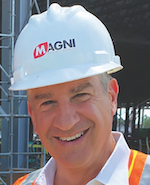 |
|
Gary N. Weisman |
Remote control can differentiate rental equipment
Remote-controlled equipment is nothing new to Magni Telescopic Handlers. All Magni machines including rotating, fixed boom and heavy lift models can be operated using a radio remote control. Magni’s Rotating Telehandlers offer a standard remote that allows the use of all boom functions and an enhanced remote option that allows the operator to stabilize and drive the machine along with visualizing the main machine parameters. A remote provides exceptional benefits when used with a Magni including:
- Increased safety: Allowing the operator to work at a safer distance reduces the risk of accidents and injuries in hazardous environments or during tasks that involve lifting unstable structures or materials. Another benefit of a Magni rotating telehandler is the benefit of using the rotating function.
- Increased efficiency: When combined with a Magni rotating telehandler, the need to pick and carry material is eliminated. The user just sets the machine, then takes the remote control and rotates the machine to pick and place material rather than driving around the job site. This reduces the risk of struck-by and other types of accidents.
- Increased productivity: Remote control enables operators to have a better view of the entire work area than just in a cab. This leads to improved precision and faster completion of tasks.
- Reduced labor costs: By providing for operation out of the machine, the operator can now perform multiple functions such as bringing the load to themselves and assuring it is placed carefully and accurately. This serves to potentially reduce the labor needed to perform many tasks.
The most important thing is to embrace is the fact that with the right machines, the remote provides end-user customers with significant benefits relating to safety and productivity. If you want to differentiate and provide greater value to your customers, then this is for you. Rental center decision makers need to evaluate which equipment would make the most sense in adding this feature. Consider the types of projects your customers undertake and ensure the equipment aligns with those job requirements. It’s essential to offer a variety of options to cater to different job sizes and industries.
Rental centers need to implement proper training programs for customers who rent the machine with a remote-control option. Ensure users understand how to operate the equipment safely and effectively and offer technical support and troubleshooting assistance to renters as they may be less familiar with the functions.
Develop comprehensive safety protocols and guidelines for both rental center staff and customers. It may present unique safety challenges, and everyone involved should be aware of the necessary precautions.
Develop marketing strategies to promote the availability and benefits of the remote-controlled equipment in your rental fleet.
Magni believes its units are the safest and most productive telehandlers available today. Once rental customers understand this, the discussion is no longer centered on price; rather, it is about value. This allows the rental center to charge a rental fee that provides a strong ROI. When paired with remote technology, these benefits get multiplied.
Best practices for rental centers include documenting and quantifying the features and benefits provided. Understand and promote the safety benefits of remote-controlled units; by offering demonstrations to prospective customers is a great way to accomplish this.
 |
| Steve Kiskunas Product Manager, Telescopic Handlers Manitou |
Manitou’s MRT Vision+ lineup of rotating telehandlers feature two remote control options: one to provide remote control of the boom when the unit is on stabilizers and the second to provide remote control of the drive and boom operation while on tires.
The MRT telescopic handlers can perform multiple roles based on the attachment connected to the machine. Use forks and carriage for palletized load placement, jibs for suspended loads and work platforms for aerial platform use. With aerial platforms, remote controls are key to machine operation, as those workers in the platform become the operators while in the work platform and the boom remote control capabilities allow the operator to stand and move along with the load they are managing. This helps improve movement, placement and overall accuracy. For instance, the operator can stand on the third floor of a building and guide that load into exactly the point they want it, vs. counting on their perspective from the inside of the cab. Similarly, it allows the operator to stand near the item as they grab it to give them a greater perspective into the positioning and stability of the load.
Bringing remote-controlled units into the rental fleet takes some planning. Safety and familiarity with any piece of equipment is critical, and Manitou experts generally believe that any operator should have a working knowledge of how telehandlers work/operate before they just start working with a remote.
For the Manitou MRT machine to be used as a work platform, the boom remote control system will be needed. As this is an important feature for the full functionality of the machine, the Manitou MRT Vision Plus units include the boom remote control as standard equipment.
As with any rental product, rental center decision makers should understand whether there is a demand in the market for that machine. For example, a rotating telehandler with remote control capabilities is not going to make sense for every rental business. A local market study of construction equipment in use will help determine the equipment needed.
TO assimilate remote-controlled units into the fleet, rental center staff must learn more about them and be able to educate rental center clients. Rotating telehandlers can be a centralized, all-purpose material handling resource on job sites of all sizes, especially as vertical construction begins. The ability to take that operator out of the cab and to give him or her the perspective of all work areas without having to move the machine, can be a game changer in terms of productivity, accuracy and operator confidence.
 |
|
Mark Piotto |
Supervised autonomy: A novel approach
Teleo retrofits existing heavy equipment and turns them into supervised autonomous and remote-operated machines. The biggest challenge facing the construction industry is a worsening shortage of skilled labor. At Teleo, we offer a turn-key solution that lets operators control any heavy equipment without stepping foot in the cab, enabling a single operator to control multiple pieces of equipment from a remote command center. By operating multiple machines at once, operators can multiply their productivity, and moving an operator from the cab to a comfortable workstation offers a much improved role that can attract more operators and reduce workplace incidents.
Teleo is introducing an incremental approach to autonomy with the Teleo Supervised Autonomy system, which combines remote operations and autonomy. Full equipment autonomy is many years away and autonomous construction equipment still requires human intervention. Supervised Autonomy works by allowing an operator to oversee the autonomous system as it performs specific tasks remotely perform such as complex tasks that the system cannot yet handle, ensuring smooth operations.
Teleo retrofits any make and model equipment, such as wheel loaders, dozers, and articulated and rigid frame trucks. Retrofitted machines can be operated from any location equipped with a Teleo command center — even from thousands of miles away. Whether on-site or long-distance, the command center enables the operator to control equipment from the comfort of an office with a 360-degree field of view around the machine with sound and vibration feedback. Command centers can also be stationed inside mobile units, like shipping containers, trailers or vans, offering multiple options for deploying Teleo’s system through rental agreements. This gives rental centers the opportunity to provide equipment as well as industry-leading technology to customers to tackle labor shortages while improving their bottom time.
Teleo also offers unprecedented visibility into operations with Teleo’s Insite analytics platform. This allows viewers to see live operations, camera recordings, operational statistics. and more. Teleo camera feeds offer the same 360-degree field of view around machines, making investigating and reporting incidents simple. To reduce incidents overall, Teleo technology includes collision avoidance systems, such as object detection that classifies obstacles and stops the machine if danger is detected.
Teleo has customers around the globe who are leveraging remote operations and supervised autonomy to attract operators, multiply productivity, and improve their bottom lines.
This article originally appeared in the September-October 2023 issue of Pro Contractor Rentals magazine. ©2023 Urbain Communications LLC. all rights reserved.




